Firearm Function Testing
It is not too uncommon in shooting investigations
for a suspect or victim to claim that a firearm accidentally discharged when it was
dropped or otherwise mishandled. The accidental discharge of a firearm can occur and most
of the time the only harm done is a hole shot in Uncle Pete's pick-up truck. However, all
too frequently deaths and serious injuries result from the accidental discharge of a
firearm.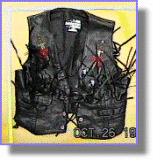
This vest contained a
derringer in its right front pocket. The wearer removed the vest and tossed it to a table.
The derringer's hammer struck the table and the derringer discharged causing the large
hole seen in the picture below. The bullet struck the owner in the chest, killing her
instantly.
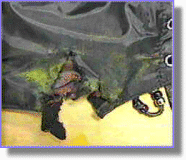 The
firearm examiner's job usually involves the
inspection of submitted firearms to determine if there is any basis for a claim of
accidental discharge. The
firearm examiner's job usually involves the
inspection of submitted firearms to determine if there is any basis for a claim of
accidental discharge.
When a firearm is submitted
to the laboratory there are a number of tests performed to determine if the firearm is
functioning properly. The firearm is inspected for damaged, worn, or missing parts and it
is examined to determine what safeties, if any, are incorporated into the design of the
firearm.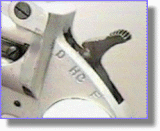
In the case mentioned above,
the derringer was not found to have any mechanical deficiencies. However, the derringer
had a safety that required the operator to manually cock its hammer back into a half-cocked position prior to loading. Without engaging the safety the hammer would be resting
directly against the firing pin of one of the derringer's chambers.
Most modern
manufactured and a great number of antique firearms have some type of safety
designed to minimize the potential for accidental discharge.
There are some firearms however, that do not have safeties.
Safeties
usually act to block the trigger, hammer, or firing pin of a firearm
and some even have multiple safeties.
Safeties can come in many forms and can be of the external manually operated
variety or
can be internal and operate automatically as a function of the
firearms action.
One of
the most common external safeties is the Cross Bolt Safety as
seen below. This safety is operated by lateral force on a button
usually located on the trigger guard of a firearm. When engaged
this safety prevents the trigger of the firearm from being
pulled. This safety is very common in rifles and shotguns.
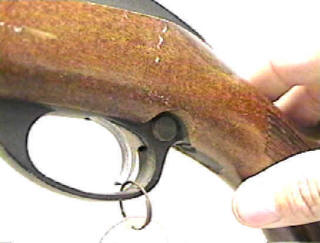
Another
external and manually operated safety, common to semiautomatic pistols, is a Sliding Button
Safety. This safety is operated by a sliding motion and is typically
located on the left side of the firearm's frame as seen below. When
engaged this safety can block the trigger and can disengage or block the
internal sear.
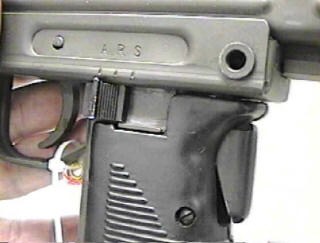
Another
external safety seen in the image above is called a Grip
Safety. Located on the back of the grip, this safety button is
depressed by your hand while gripping the firearm. If not
depressed the grip safety blocks the trigger from being pulled.
The Thumb
Safety seen below is another common pistol safety. This safety
usually located on the slide can block the hammer from striking the
firing pin, will sometimes de-cock the pistol's hammer, and can
disengage the trigger mechanism.
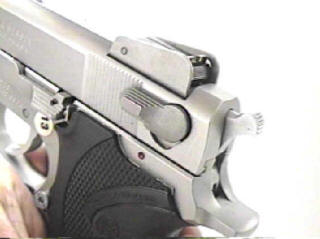
The Transfer
Bar Safety seen below is found in RUGER and other revolvers.
Connected to the trigger the transfer bar must be in the up position for
energy to be transferred from the hammer to the frame-mounted firing
pin. As long as pressure is maintained on the revolver's trigger
the transfer bar will be in the up position. If pressure is not
maintained on the trigger the transfer bar will move down and out of the
way as the hammer falls and as a result the hammer will not transfer its
energy to the firing pin and the revolver will not fire. This
safety will prevent the accidental discharge of the revolver if the
cocked hammer were to "jar-off" when dropped. It will also
prevent discharge if a blow is delivered to the back of an un-cocked
hammer.
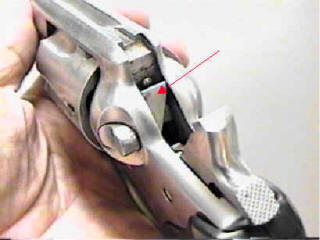
The Hammer
Block Safety, common to revolvers with hammer-mounted firing pins, is
connected to the trigger mechanism and works in a fashion opposite that
of the transfer bar safety. The image below shows a Smith
& Wesson revolver with the hammer in the uncocked position.
The hammer block is highlighted in red. In this position the
hammer block is in the up position and will prevent the hammer-mounted
firing pin from moving through the frame.
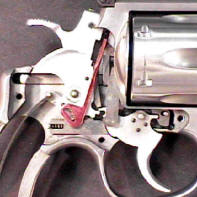
The image
below shows the hammer in the cocked position. The hammer block moves
down when the hammer is cocked and as long as the trigger is held to the
rear will stay down and out of the way as the hammer falls. If
pressure is not maintained on the trigger it will recover forward as the
hammer falls and the hammer block will move up preventing discharge of
the revolver.
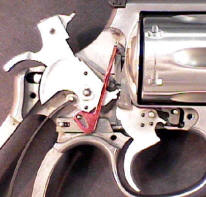
The image below shows a cut-away of a Glock
semiautomatic pistol. Glock pistols and many other
semiautomatic pistols have an internal Firing Pin Safety.
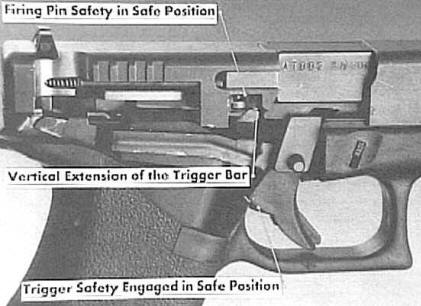
It is a little difficult to see but when the trigger is forward a small
internal plunger is blocking the pistol's firing pin. The plunger
must be pushed up to unlock the firing pin. When the trigger is
pulled to the rear the trigger bar pushes the plunger up just before the
release of the hammer or firing pin.
Also seen
in the image above is the Glock Trigger Safety. This
external safety is a small extension on the forward edge of the trigger
must be depressed before the trigger can be pulled.
The safeties described above
are only some of the more common varieties. Safeties can be very
effective in preventing the accidental discharge of a firearm
however, it should be noted that even the most sophisticated
firearms have been known to discharge unexpectedly. Have
you ever heard of Murphy's Law? User error, dirt, damage
and/or poor design can contribute to any inadvertent discharge.
Firearm examiners will inspect the firearms collected from
shooting incidents to document the overall condition and
operability of the firearm in question.
|